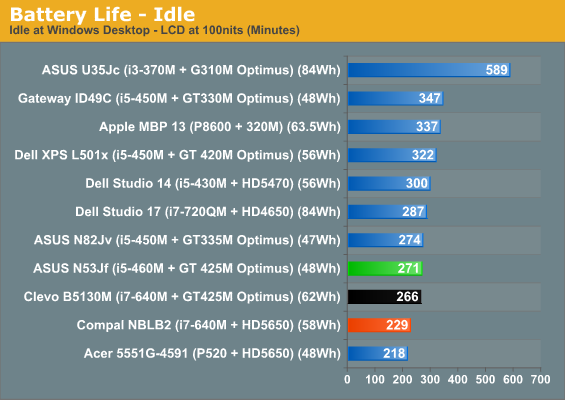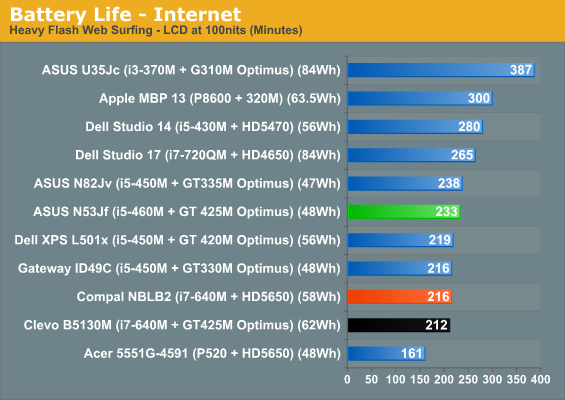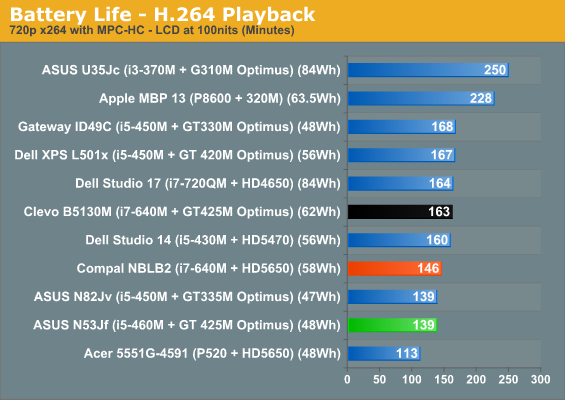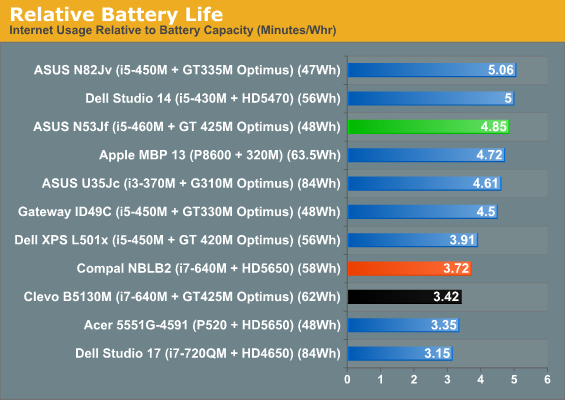ASUS N53JF: Midrange 15.6” 1080p, Take Four
by Jarred Walton on December 28, 2010 1:40 AM ESTASUS N53JF Battery Life: Not Bad for 48Wh, but Please Give Us 63Wh!
We’ve complained about the use of older and smaller 48Wh batteries in midrange notebooks quite a few times, but the N53JF continues that trend. That puts it at a definite disadvantage relative to Dell XPS’ 56Wh battery, as well as Compal’s 58Wh and Clevo’s 62Wh offerings. But higher capacity isn’t the only game in town; making better use of that capacity is still possible with BIOS and hardware optimizations, and ASUS does very well in this regard. Combined with NVIDIA’s Optimus Technology, we end up with roughly four hours of useful battery life, or just under 2.5 hours of H.264 playback.
ASUS also has their “Super Hybrid Engine” available, which underclocks the CPU and locks the maximum multiplier when enabled. We test with modified Power Saver settings normally, which already locks the CPU multiplier to the minimum, but SHE is still able to wring an extra few minutes out of the battery. We left it enabled for the battery life testing, so the results are the best-case scenario. We also disable any unnecessary utilities and software, and set the LCD to 100nits (45% in this case).




Despite having a smaller battery, ASUS beats the Clevo notebook in two of the three tests. The Compal result on the other hand isn’t so surprising, given the always-on GPU. We commented in the past that the Dell XPS had a substandard Internet result (despite multiple test runs), and that shows up again as the one inexplicable loss to the ASUS. In general, though, battery life is decent and enough for typical users. You’ll still want the power brick handy if you play any games or want to watch a Blu-ray from an actual disc, however—we measured just 90 minutes playing an 35Mbps AVC Blu-ray video (Jumper).










65 Comments
View All Comments
Luke2.0 - Friday, December 31, 2010 - link
Aww.... I see. I must have had false first impression when first getting in touch with Asus G51 specification, now that one feels real huge.Still, when you mentioned in the review this N53J being "heavier, wider, thicker, deeper than that one which in turn slightly larger than yet another one" I had some hopes LOL. (Not blaming you for this)
Thanks anyway.
Happy New Year 2011~~~
JarredWalton - Sunday, January 2, 2011 - link
I think the G51 is indeed heavier and larger than the N53; I was comparing the N53 to the Dell XPS 15. The G53JW in fact does support two hard drives, and it actually has some really interesting specs. When the Sandy Bridge refresh of that unit comes around, I'll be sure to hound ASUS about getting a review sample. We've looked at G73 twice, but no G53 yet.Luke2.0 - Monday, January 3, 2011 - link
Hi Jarred, I suppose you are busying yourself with new top-notch toy named Sandy Bridge.However, I stumbled upon this yesterday
http://forum.notebookreview.com/asus-reviews-owner...
Member "mzil" of the forum suspects the brightness level was not maxed during the test due to the reason he explained in there. Perhaps you could do a short check if this is so (and thus the display might be better than as recently reviewed)?
Let us know how things turn out, won't you? =)
Thank you.
(Gotta read the SNB review asap, thanks for this one as well)
manu12 - Wednesday, January 12, 2011 - link
there's something strange in your tests.For the Dell XPS15 laptop you specificy a
( 15.6" WLED Glossy 16:9 1080p (1920x1080) - AU Optronics B156HW1) screeh;
and you do the same for this Asus N53JF
(15.6" B+GR LED Glossy 16:9 1080p (1920x1080) - AU Optronics B156HW1)
and you have 'graphics benches' wich are completely differents , including big differences in contrast ?!
klunoee - Wednesday, May 4, 2011 - link
The only thing B&O is the amplifier for the speakers (B&O ICEpower technology). This means that the laptop has an efficient and powerful digital amplifier, but it tells you nothing about the quality of the speakers themselves or the audio codec delivering the sound to the amplifier.